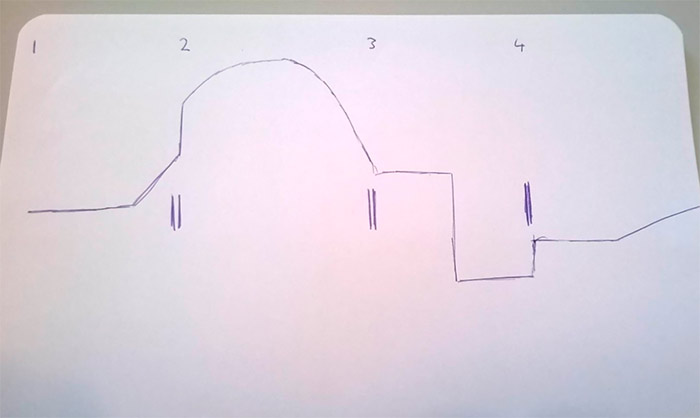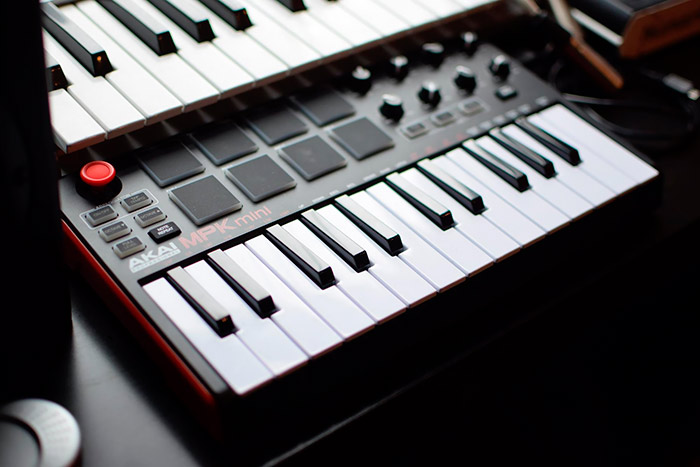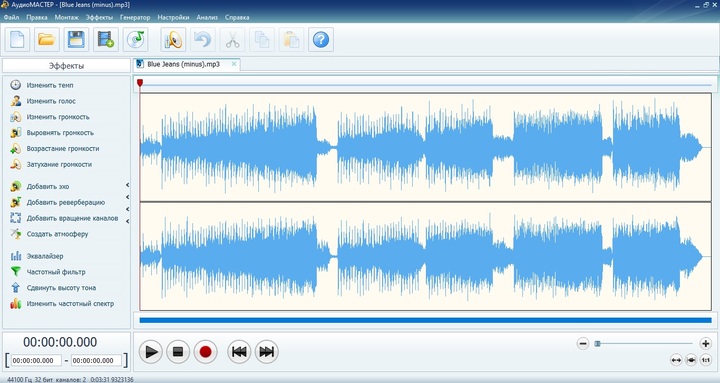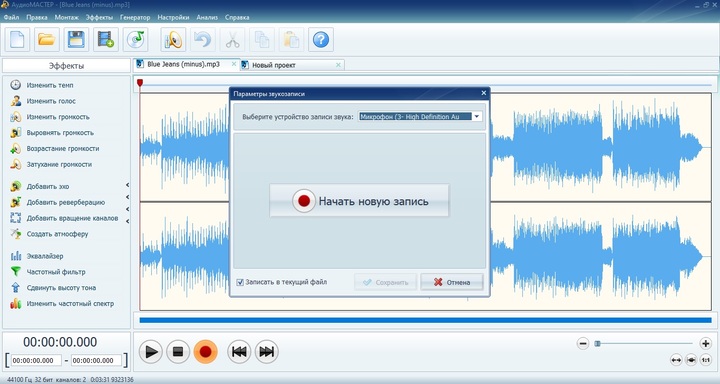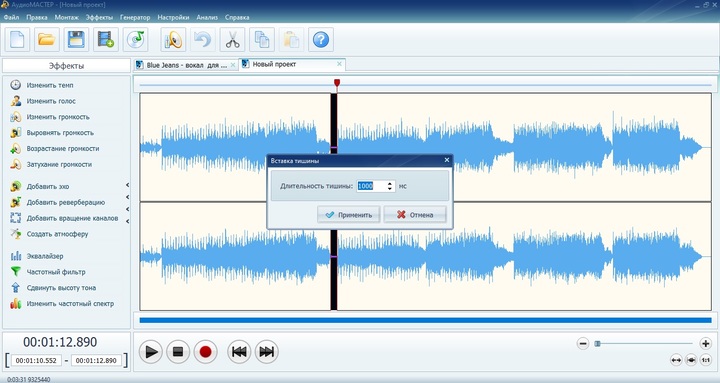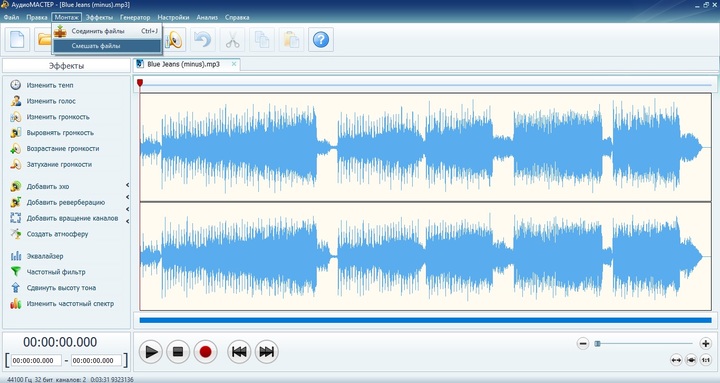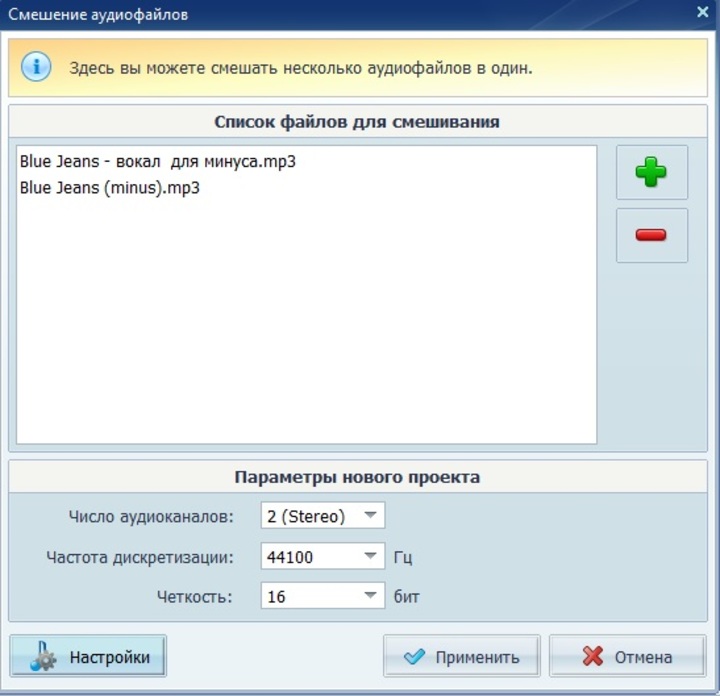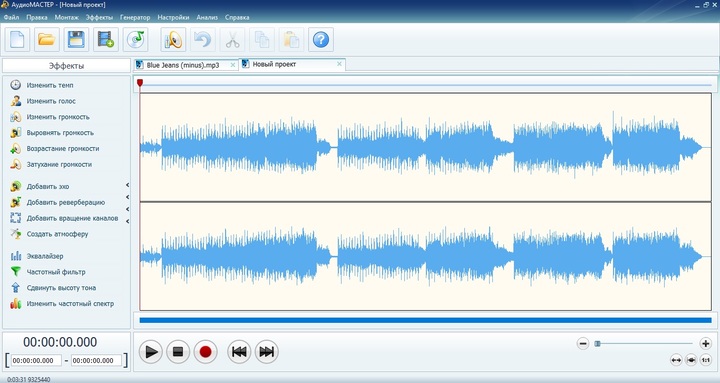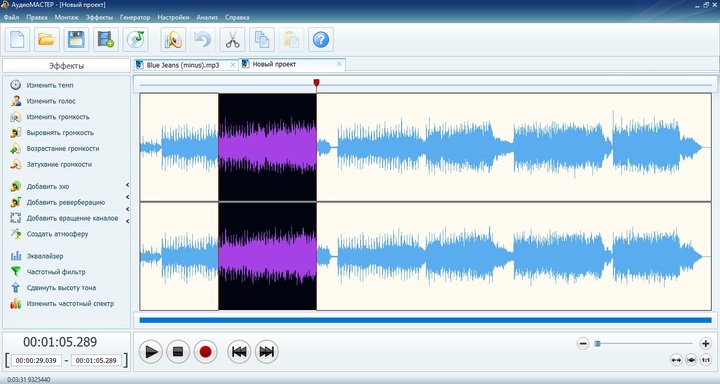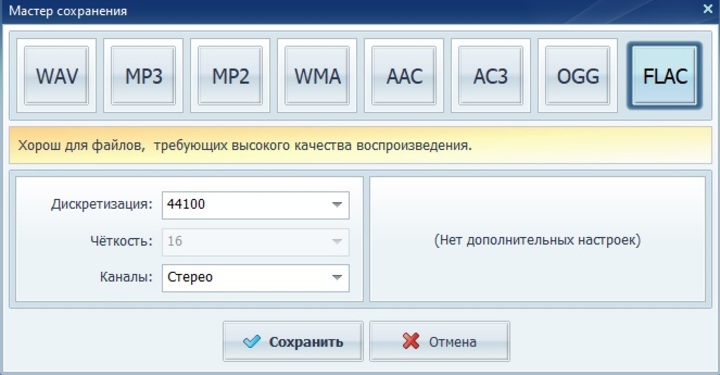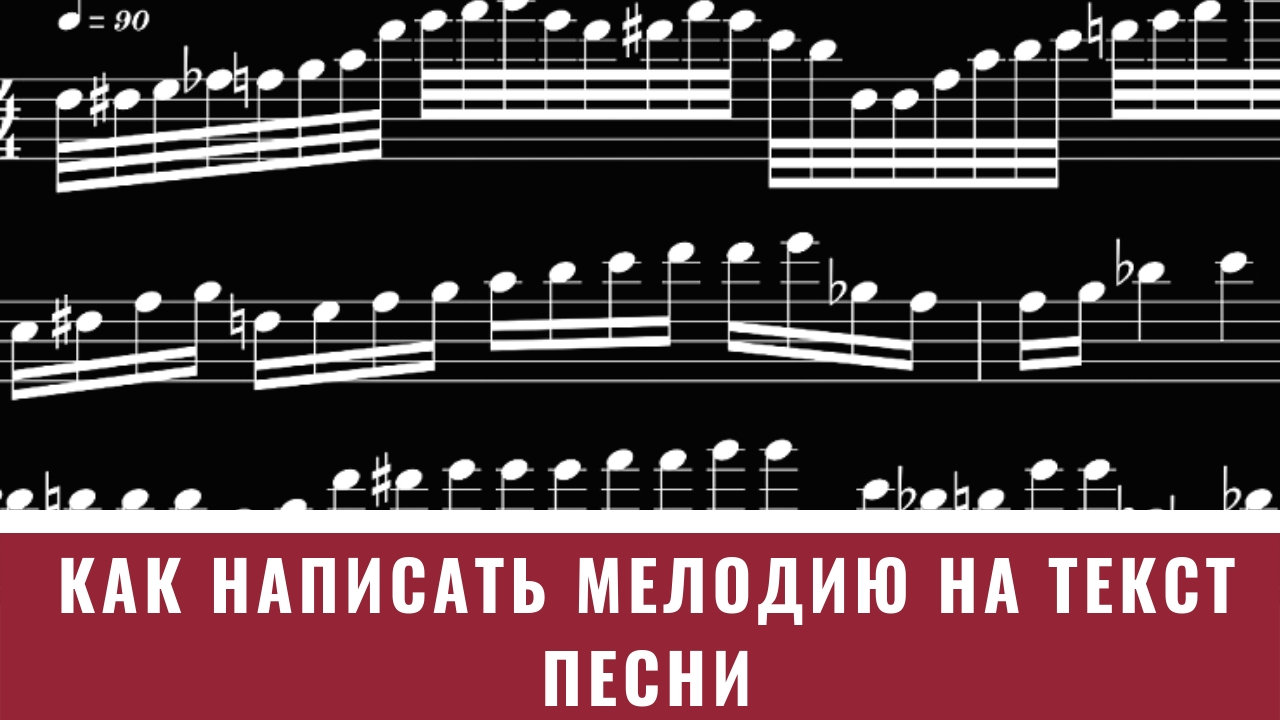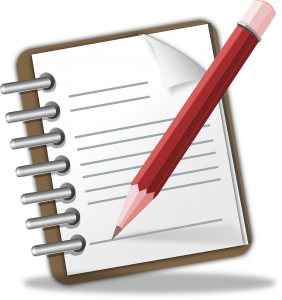Учимся писать музыку к песням с нуля –
8 профессиональных приёмов создания красивой мелодии
Подумайте о своей любимой песне. Что вы вспоминаете в первую очередь? Конечно, основную мелодию. Это важная и запоминающаяся часть композиции. Кажется, что придумать оригинальную мелодию крайне сложно, ведь бытует мнение, что в мире музыки уже все хорошие комбинации использованы. Действительно, сочинение мелодии – трудоемкий творческий процесс, но вовсе не невозможный! В данной статье мы расскажем о способах генерации новых идей и как написать музыку к песне, даже не имея музыкального образования.
Что такое мелодия?
Мелодия — это последовательность нот, сыгранных или спетых в музыкальном произведении. Простой мотив может состоять из одной музыкальной фразы – нескольких коротких нот и ничего более. Есть большое количество примеров сложных мелодий, подобных тем, которые вы слышите, например, в джазе.
Даже базового владения музыкальным инструментом достаточно, чтобы сочинить мелодию
Иногда слушатели путают понятия «мотив» и «мелодия». Они действительно похожи по некоторым характеристикам, но их нельзя смешивать. Мелодия – основная идея трека. Мотив или фраза – короткая музыкальная идея. Это могут быть несколько нот, помещенных в определенном порядке или ритме. Мотив часто повторяется, незначительно меняясь в течение песни.
Мелодия состоит из двух основных компонентов: высоты звука и длительности. В теории музыки каждая нота вибрирует на своей собственной частоте, которая определяет ее высоту – насколько «высоко» или «низко» она звучит. Продолжительность относится к тому, как долго она удерживается. Например, четвертная нота длится одну четверть продолжительности такта, написанного за 4/4 времени.
Ликбез по основным музыкальным терминам
Прежде, чем переходить к описанию приемов, остановимся на основных терминах, которые будут упоминаться. Если вы совсем новичок, эти простые определения помогут вам быстрее разобраться, о чем идет речь ниже.
- Аккорд – одновременное звучание нескольких звуков разной высоты.
- Тональность – привязка музыкального звучания (лада) к определенному участку мелодии.
- Лад – система взаимоотношений звуков, создающая звуковой эффект.
- Гамма – звуки лада, расположенные в порядке высоты.
- Минор и мажор – виды ладов. Мажорный лад подходит для создания веселой и бодрой мелодии, минорный – для меланхоличных баллад.
8 способов написания запоминающейся мелодии
Мы немного разобрались в музыкальной теории. Пора узнать, как придумать мелодию, которая идеально ляжет на созданные стихи и полюбится слушателям.
№1. Создайте план
Многие композиторы предпочитают писать произведения в свободной форме, однако иногда последовательность лучше сказывается на продуктивности. Сначала определите тип создаваемой мелодии и музыкальную форму, т.е. распорядок частей и разделов. Можете составить графический контур.
Составьте примерный план будущей мелодии
Экспериментируйте: попробуйте сначала написать припев новой песни и в дальнейшем исходить от него. Подумайте, какой куплет и проигрыш лучше подойдут к созданному куску.
Попробуйте создать отрывки, комбинируя ноты мажорной или минорной гаммы. Они составляют основу большинства поп-мелодий и подходят для песни, которая легко «застрянет» в голове.
Не забудьте включить пиковую ноту. Это высокая нота, которая появляется в песне только один раз. Убедитесь, что она попадает в диапазон голоса певца. Вы можете «сыграть против правил» и сделать ее самой низкой по тональности в композиции. Обдумайте кульминацию и где она будет находиться.
№2. Найдите вдохновение
Не бойтесь брать за референс любимые песни или популярные мелодии разных жанров. Это не означает, что вы можете полностью украсть чужое творение. Попробуйте проанализировать музыкальное произведение и понять, что сделало ее популярной. Позаимствуйте концепцию и примените ее к создаваемой композиции.
Еще один вариант – максимально измените готовую песню. Попытайтесь заменить все аспекты произведения на абсолютную противоположность – поменяйте тональность, перепишите аккорды в другой очередности. Загрузите трек на ПК в программу для создания музыки, проиграйте в обратном порядке, нарежьте куски из разных дорожек и смикшируйте. Трансформируйте произведение так, чтобы подогнать под свой уникальный авторский стиль.
№3. Подберите аккорды
Начните процесс написания с импровизации. Вы можете добиться прекрасных результатов простым перебором клавиш на пианино или гитарных струн. Запишите звук с помощью микрофона, чтобы в дальнейшем использовать в работе наиболее удачные сочетания аккордов и нот.
Не знаете, с чего начать писать музыку, а гитарный перебор не вдохновляет? Начните с мелодии из одного такта. Скопируйте его на вторую полосу и измените одну вещь. Это может быть плавный переход в другую ноту, незначительное скольжение высоты тона, изменение длительности. Продублируйте мелодию из двух тактов на третью и четвертую полосы. Измените некоторые аспекты. Теперь у вас есть небольшая мелодия.
Лучше всего использовать эту стратегию для мелодии с 4 или 8 барами. Следуйте личному вкусу – иногда может сработать и более длинные, и короткие вариации.
№4. Добавьте ритмические вариации
При написании мелодий важно уделить внимание ритму. Ритмическая последовательность нот придает мелодиям особую вибрацию и характер. Вы можете управлять им, размещая ноты по горизонтальным дорожкам в программе для создания музыки на ПК.
Не бойтесь экспериментировать с ритмикой мелодии
Чтобы создать мелодию по ритму, используйте синкопу – ритмическое смещение. Оно изменяет ноты по образцу, который отклоняется от обычного ожидаемого ритмического рисунка. Благодаря этому песня становится неординарной и отличается от подобных композиций того же жанра. Данный прием привлечет внимание слушателей, ожидающих развитие песни по привычному образцу.
№5. Используйте MIDI-клавиатуру
Импровизация на клавишных – лучший способ подстегнуть воображение. Но как сочинить мелодию на фортепиано самому, если вы не особенно хорошо играете на этом инструменте? Используйте MIDI-клавиатуру или подберите мелодию на синтезаторе.
По максимуму задействуйте возможности синтезатора при сочинении мелодии
Транспонируйте MIDI-информацию (например, аккорды или бас) на ля минор или до мажор (только белые клавиши). Зациклите ее на пять минут, нажмите запись и начните импровизировать.
Поиграйтесь с мелодическими идеями. Когда закончите, прослушайте запись. Вы можете обнаружить в нагромождении звуков идеи, которые подойдут для новой песни.
№6. Используйте MIDI-паки
Не знаете, как сочинить мелодию на гитаре, когда идей совершенно нет? Скачайте специальные MIDI-пакеты. Это готовые музыкальные сэмплы, на основе которых можно построить музыкальную композицию. Вы не сможете создать из этих отрывков полноценную песню, но они могут дать толчок для оригинальной идеи.
Многие ди-джеи и начинающие композиторы пользуются ими, поэтому лучше не вставлять их в песню без изменений. Измените тональность по ритму остальных инструментов в песне, отрегулируйте высоту, измените длительность некоторых нот.
№7. Отложите инструменты
Отложить в сторону инструменты и создать вокальную партию – отличный способ сочинить мелодию на стихи. Это хорошее упражнение, чтобы снять творческий блок и подстегнуть креативность. Прочитайте готовые строчки и попробуйте подобрать к тексту песни мелодию, пропевая их в различных вариациях.
Уделите особое внимание вокальной партии в песне
Можете скомбинировать этот метод с советом номер 3 и заменить своими стихами известную песню, затем переработать. Включите смартфон и запишите вокальные упражнения. Затем обработайте созданные фрагменты на инструменте или компьютере.
Напев на диктофон – отличный способ создавать песни, если вы не в ладах с нотами или совсем не знаете нотной грамоты. Многие известные хиты создавались таким способом.
№8. Экспериментируйте с компьютерным софтом
Для записи мелодии на компьютер не требуется профессиональная техника. Понадобится лишь специальная программа, помогающая сочинять музыку. АудиоМАСТЕР – удобный редактор для начинающих музыкантов с функциями записи, обработки и микширования.
АудиоМАСТЕР поможет записать мелодию и при необходимости ее улучшить
В программе доступны опции аудиомонтажа: можно соединить или смешать несколько записанных кусков в один фрагмент. У созданного фрагмента можно настроить звучание эквалайзером: усилить басы, подавить посторонние шумы. Также можно сместить высоту тона на заданное количество герц. Присутствует частотный спектр, который поможет изменить плотность звука, настройка реверберации, работа с громкостью и возможность добавлять поверх аудио различные эффекты.
Дополнительные подсказки для новичков
Иногда вдохновение не приходит, а трудолюбие не помогает. В таких ситуациях попробуйте следующие приемы:
- работайте в полной тишине;
- попробуйте другой инструмент;
- переместите ноту вверх или вниз на одну октаву;
- удалите каждую вторую ноту.
При создании песни способом подбора аккордов:
- работайте с ритмом аккордовой последовательности;
- обращайте особое внимание на ноту перед сменой аккорда.
Чего следует избегать:
- Излишнего разнообразия. Запоминающаяся мелодия должна повторяться.
- Слишком резких изменений в высоте тона и ритме. Последовательность – ключ к успеху.
Написание мелодии – важнейшая часть в создании музыкальной композиции. Нельзя предугадать, как правильно сочинять музыку, поэтому важно найти личный стиль. Практикуйтесь каждый день, вдохновляйтесь признанными или малоизвестными шедеврами музыки, а АудиоМАСТЕР поможет разобраться, как сочинить музыку на компьютере. Скачайте софт, следуйте указанным советам в статье и создавайте из них яркие композиции.
Вас также может заинтересовать
Download Article
Download Article
You may have had some killer song lyrics pop into your head one day out of the blue, or maybe you’re an amateur poet with some verses that would work perfectly put to music. Whatever your case may be, if you have lyrics itching for a tune, with a little time and effort your lyrics can have musical accompaniment. Evaluate the tone and imagery in your lyrics to help direct your choices for the tune. Set a tune to your lyrics by dividing the lyrics into syllables and assigning each syllable a note/tone. After that, achieve success as a music producer by improving your song through critique and building a social media following.
-
1
Determine the tone of the lyrics. The tone of your song will guide a lot of the choices you make regarding the tune. For example, lyrics that are sinister and dark would be suited to minor chords or scales, which generally sound gloomy, somber, or creepy.[1]
- A bright, happy sounding song would work well with major chords and scales. Experiment to find what works best with your lyrics.
- Light, frolicking lyrics could work well with quick, split note rhythms, like runs of eighth or sixteenth notes.
- Dramatic lyrics can be highlighted with power chords. Use these to punch up drama at points throughout the song.
-
2
Allow the imagery of the lyrics to shape the tune. Your tune should have contour. A gentle rise and fall in the tones of your tune would be suitable for soft, mellow, or soulful songs, like pastorals or songs about natural beauty. Large tonal jumps can add edge, heightened emotion, and showmanship, like might be suitable for a rock ballad.[2]
- Ask yourself, «What is the setting of this song?» Use this question as a guide for the choices you make when producing the tune.
- What images are brought to mind when you read the lyrics? If you see gentle, rolling hills, you could decrease the tonal contour of the tune to imitate this quality.
- Setting includes weather and atmospheric lighting. Songs that might be useful for gaining a sense of this include «L’orage» (The Storm) by Burgmüller, «The Planets» by Holst, and Prelude, Op 28, No. 15 («Raindrop») by Chopin.
Advertisement
-
3
Reflect the living world in your tune. Your song may have a quality similar to a living creature, like «The Flight of the Bumblebee» by Rimsky-Korsakov. In this song, Rimsky-Korsakov uses quick runs of broken notes to imitate the chaotic, rapid fluttering of wings and the industriousness of bees.[3]
- Your lyrics may have the sense of a creeping predator, like a large cat stalking its prey. This could be imitated in the tune with a flowing tonal contour that builds to edgy minor chords.
- There may be a point in your song that moves at a gallop, like a horse. Include broken note runs and bright, free sounding major chords.
- Other songs you might want to listen to for a better understanding of the living quality of songs include «Dragonfly Keeper» by Phildel, «Madama Butterfly» by Puccini, and the French horn (wolf) part of the opera Peter and the Wolf by Prokofiev.
Advertisement
-
1
Write out your lyrics on staff paper. Staff paper has groupings of five lines on which musical notes are drawn. Alternatively, you can type up your lyrics in a music making program on a computer. Placing the lyrics side by side with the staff will help you to connect each word/syllable of your lyrics with its associated part in the tune.[4]
- Some music making programs you can use on your computer include Ableton Live, Fruity Loops (FL) Studio, Steinberg Cubase Pro, and Apple Logic Pro.[5]
- It’s best to use a pencil when drafting your song on staff paper. You’ll likely have to make changes as the song develops.
- Some music making programs you can use on your computer include Ableton Live, Fruity Loops (FL) Studio, Steinberg Cubase Pro, and Apple Logic Pro.[5]
-
2
Break each word into syllables. This is a simple way of making sure each syllable gets a note. In some cases, you may want to sustain a note through several syllables or break up a note into a run for a single syllable.[6]
- Even if you plan on stretching a note out over many syllables, breaking lyrics into syllables will help you keep track of the beat.
-
3
Choose a note/tone for each syllable. Generally, each syllable of the lyrics should receive a tone. This forms the main throughline of the song, which is often referred to as the «melody.»[7]
Keep the overall contour, imagery, and alive (animalistic) qualities of your lyrics in mind while choosing the range of tones for your tune.[8]
- Sometimes, at the end of a musical phrase, a sustained note can add impact and feeling. Experiment with sustained notes to find what works best for your lyrics.
- In some cases, you may want to leave out music to showcase the lyrics. This is called a «rest» in music. Try inserting a rest for certain syllables to add tension.
-
4
Listen to your melody. If you’re making music on your computer, you’ll likely be able to play the melody you’ve composed through headphones or speakers. Listen to the recording throughout the composing process, and adjust it to suit your preferences and style.
- Listen to your track and the various parts you add to it throughout the music production. Sometimes tones, chords, or instruments that you expect will work won’t sound very good, and vice versa.
- Continue to make adjustments to the parts you’ve written or the parts you’ll add later as your song takes shape. Change the music with your pencil and eraser or composing software on your computer.
-
5
Add in other instruments. Be sparing with the instruments you add. Too many can contribute to a muddy or oversaturated sound. Limiting the number of instruments (including voices) you add to your song to seven or fewer will help prevent this.[9]
- Create harmony between the main throughline of your song (melody) and the parts played by other instruments.
- Add more instruments to the mix when at high energy, dramatic, or emphasized moments in your lyrics. Doing so can amplify these qualities.
EXPERT TIP
Halle Payne
Singer/Songwriter
Halle Payne has been writing songs since the age of eight. She has written hundreds of songs for guitar and piano, some of which are recorded and available on her Soundcloud or Youtube channel. Most recently, Halle was a part of a 15-person collaboration in Stockholm, Sweden, called the Skål Sisters.
Halle Payne
Singer/SongwriterHalle Payne, singer/songwriter, tells us: «Most songs build and develop over the course of the track. You might start with just piano, then stack guitar, vocals, and vocal harmonies on top as the song builds. Later in the song, you might strip all of that away, and then come back for a big final chorus!»
Advertisement
-
1
Get feedback on your song. It’s likely you’ll spend a lot of time working on your song. This makes it easy to miss certain things. A fresh pair of ears can help you identify trouble spots. Ask for specific feedback and use this to adjust your song or create new songs.
- Your family and friends may not be completely honest with you to protect your feelings. For this reason, you should also play your song for people who don’t know you as well.
-
2
Upload your music to a digital platform. Record your song, if necessary. Post it on platforms like YouTube, SoundCloud, BandCamp, Spotify, and more. Use appropriate tags and labels when you post, like «drum and bass,» «folk music,» or «hip hop.» Without proper tagging and labeling, your uploaded music will be hard for listeners to find.
- Remember to include sub-genres or associated tags. To the tag «drum and bass,» you might add, «uptempo,» «sunny,» or «liquid» to provide more information on your song at a glance.
- Use the public reaction to your song to improve it. However, take online criticism with a grain of salt. Some critique may be unfounded or even cruel.
-
3
Build your online presence. Use social media, like Twitter, Facebook, YouTube, and similar social media sites to connect with fans. Post information about new releases, merchandise, and upcoming performances. Communicate and network with other music professionals through these sites.
- Building an online following can take a lot of work. Many professional songwriters have their online accounts managed by publicists and agents.
- Hold contests through social media to drum up fan involvement. For example, you might give away free merchandise to certain fans through a social media raffle.[10]
-
4
Connect with other songwriters and music professionals. Relationships with other songwriters and music professionals can open up new opportunities for your career. These people can put you in touch with event staff, help you promote new work, and might even be valuable collaborators down the road.
- A business card will make it easy for you to pass off your contact information to suitable individuals even at distracting or loud events.
- Send a friendly message through email or social media to new acquaintances after you meet them.[11]
Advertisement
Add New Question
-
Question
Do you have any advice to help find the tune of a ballad?
Finding the tune for a ballad depends largely on the kind of ballad you’re trying to put together. A rock ballad, for example, would be different from a traditional British ballad. Check out the wikiHow for how to Write a Ballad.
-
Question
What if I don’t know how to play the instrument?
You can teach yourself with online videos or get a teacher to give you lessons.
-
Question
How can I make an easy melody as a kid?
I’m 13, but I’ve written a few songs. I suggest using major keys only to begin with to make life easy. Look up poems 4 lines long that rhyme to help you develop rhyming lyrics that fit.
See more answers
Ask a Question
200 characters left
Include your email address to get a message when this question is answered.
Submit
Advertisement
Thanks for submitting a tip for review!
-
Copying a tune note for note is plagiarism and can get you into legal trouble.
Advertisement
Things You’ll Need
- Staff paper (or computer program for writing music)
- Lyrics
- Pencil
- An instrument
References
About This Article
Article SummaryX
Putting a tune to song lyrics can seem daunting, but if you break the process up into steps, it will be a lot easier. If you’re not sure where to start, break up each word in your lyrics into syllables. Then, choose a note for each syllable. In general, each syllable should have a tone, but you can also add rests to emphasize certain lyrics. Once you have a basic melody you like, you can start adding instruments! Experiment on your chosen instrument until you find something that sounds right. If you’re having trouble playing what you want, try using music software like Ableton Live or Fruity Loops to experiment with different melodies. Then, listen back to your melodies and make adjustments to the parts until it sounds right. To learn how to be a successful music producer, read on!
Did this summary help you?
Thanks to all authors for creating a page that has been read 145,036 times.
Reader Success Stories
-
«It is an article that helps me a lot you know, some of the things I did not understand and through this article I…» more
Did this article help you?
Download Article
Download Article
You may have had some killer song lyrics pop into your head one day out of the blue, or maybe you’re an amateur poet with some verses that would work perfectly put to music. Whatever your case may be, if you have lyrics itching for a tune, with a little time and effort your lyrics can have musical accompaniment. Evaluate the tone and imagery in your lyrics to help direct your choices for the tune. Set a tune to your lyrics by dividing the lyrics into syllables and assigning each syllable a note/tone. After that, achieve success as a music producer by improving your song through critique and building a social media following.
-
1
Determine the tone of the lyrics. The tone of your song will guide a lot of the choices you make regarding the tune. For example, lyrics that are sinister and dark would be suited to minor chords or scales, which generally sound gloomy, somber, or creepy.[1]
- A bright, happy sounding song would work well with major chords and scales. Experiment to find what works best with your lyrics.
- Light, frolicking lyrics could work well with quick, split note rhythms, like runs of eighth or sixteenth notes.
- Dramatic lyrics can be highlighted with power chords. Use these to punch up drama at points throughout the song.
-
2
Allow the imagery of the lyrics to shape the tune. Your tune should have contour. A gentle rise and fall in the tones of your tune would be suitable for soft, mellow, or soulful songs, like pastorals or songs about natural beauty. Large tonal jumps can add edge, heightened emotion, and showmanship, like might be suitable for a rock ballad.[2]
- Ask yourself, «What is the setting of this song?» Use this question as a guide for the choices you make when producing the tune.
- What images are brought to mind when you read the lyrics? If you see gentle, rolling hills, you could decrease the tonal contour of the tune to imitate this quality.
- Setting includes weather and atmospheric lighting. Songs that might be useful for gaining a sense of this include «L’orage» (The Storm) by Burgmüller, «The Planets» by Holst, and Prelude, Op 28, No. 15 («Raindrop») by Chopin.
Advertisement
-
3
Reflect the living world in your tune. Your song may have a quality similar to a living creature, like «The Flight of the Bumblebee» by Rimsky-Korsakov. In this song, Rimsky-Korsakov uses quick runs of broken notes to imitate the chaotic, rapid fluttering of wings and the industriousness of bees.[3]
- Your lyrics may have the sense of a creeping predator, like a large cat stalking its prey. This could be imitated in the tune with a flowing tonal contour that builds to edgy minor chords.
- There may be a point in your song that moves at a gallop, like a horse. Include broken note runs and bright, free sounding major chords.
- Other songs you might want to listen to for a better understanding of the living quality of songs include «Dragonfly Keeper» by Phildel, «Madama Butterfly» by Puccini, and the French horn (wolf) part of the opera Peter and the Wolf by Prokofiev.
Advertisement
-
1
Write out your lyrics on staff paper. Staff paper has groupings of five lines on which musical notes are drawn. Alternatively, you can type up your lyrics in a music making program on a computer. Placing the lyrics side by side with the staff will help you to connect each word/syllable of your lyrics with its associated part in the tune.[4]
- Some music making programs you can use on your computer include Ableton Live, Fruity Loops (FL) Studio, Steinberg Cubase Pro, and Apple Logic Pro.[5]
- It’s best to use a pencil when drafting your song on staff paper. You’ll likely have to make changes as the song develops.
- Some music making programs you can use on your computer include Ableton Live, Fruity Loops (FL) Studio, Steinberg Cubase Pro, and Apple Logic Pro.[5]
-
2
Break each word into syllables. This is a simple way of making sure each syllable gets a note. In some cases, you may want to sustain a note through several syllables or break up a note into a run for a single syllable.[6]
- Even if you plan on stretching a note out over many syllables, breaking lyrics into syllables will help you keep track of the beat.
-
3
Choose a note/tone for each syllable. Generally, each syllable of the lyrics should receive a tone. This forms the main throughline of the song, which is often referred to as the «melody.»[7]
Keep the overall contour, imagery, and alive (animalistic) qualities of your lyrics in mind while choosing the range of tones for your tune.[8]
- Sometimes, at the end of a musical phrase, a sustained note can add impact and feeling. Experiment with sustained notes to find what works best for your lyrics.
- In some cases, you may want to leave out music to showcase the lyrics. This is called a «rest» in music. Try inserting a rest for certain syllables to add tension.
-
4
Listen to your melody. If you’re making music on your computer, you’ll likely be able to play the melody you’ve composed through headphones or speakers. Listen to the recording throughout the composing process, and adjust it to suit your preferences and style.
- Listen to your track and the various parts you add to it throughout the music production. Sometimes tones, chords, or instruments that you expect will work won’t sound very good, and vice versa.
- Continue to make adjustments to the parts you’ve written or the parts you’ll add later as your song takes shape. Change the music with your pencil and eraser or composing software on your computer.
-
5
Add in other instruments. Be sparing with the instruments you add. Too many can contribute to a muddy or oversaturated sound. Limiting the number of instruments (including voices) you add to your song to seven or fewer will help prevent this.[9]
- Create harmony between the main throughline of your song (melody) and the parts played by other instruments.
- Add more instruments to the mix when at high energy, dramatic, or emphasized moments in your lyrics. Doing so can amplify these qualities.
EXPERT TIP
Halle Payne
Singer/Songwriter
Halle Payne has been writing songs since the age of eight. She has written hundreds of songs for guitar and piano, some of which are recorded and available on her Soundcloud or Youtube channel. Most recently, Halle was a part of a 15-person collaboration in Stockholm, Sweden, called the Skål Sisters.
Halle Payne
Singer/SongwriterHalle Payne, singer/songwriter, tells us: «Most songs build and develop over the course of the track. You might start with just piano, then stack guitar, vocals, and vocal harmonies on top as the song builds. Later in the song, you might strip all of that away, and then come back for a big final chorus!»
Advertisement
-
1
Get feedback on your song. It’s likely you’ll spend a lot of time working on your song. This makes it easy to miss certain things. A fresh pair of ears can help you identify trouble spots. Ask for specific feedback and use this to adjust your song or create new songs.
- Your family and friends may not be completely honest with you to protect your feelings. For this reason, you should also play your song for people who don’t know you as well.
-
2
Upload your music to a digital platform. Record your song, if necessary. Post it on platforms like YouTube, SoundCloud, BandCamp, Spotify, and more. Use appropriate tags and labels when you post, like «drum and bass,» «folk music,» or «hip hop.» Without proper tagging and labeling, your uploaded music will be hard for listeners to find.
- Remember to include sub-genres or associated tags. To the tag «drum and bass,» you might add, «uptempo,» «sunny,» or «liquid» to provide more information on your song at a glance.
- Use the public reaction to your song to improve it. However, take online criticism with a grain of salt. Some critique may be unfounded or even cruel.
-
3
Build your online presence. Use social media, like Twitter, Facebook, YouTube, and similar social media sites to connect with fans. Post information about new releases, merchandise, and upcoming performances. Communicate and network with other music professionals through these sites.
- Building an online following can take a lot of work. Many professional songwriters have their online accounts managed by publicists and agents.
- Hold contests through social media to drum up fan involvement. For example, you might give away free merchandise to certain fans through a social media raffle.[10]
-
4
Connect with other songwriters and music professionals. Relationships with other songwriters and music professionals can open up new opportunities for your career. These people can put you in touch with event staff, help you promote new work, and might even be valuable collaborators down the road.
- A business card will make it easy for you to pass off your contact information to suitable individuals even at distracting or loud events.
- Send a friendly message through email or social media to new acquaintances after you meet them.[11]
Advertisement
Add New Question
-
Question
Do you have any advice to help find the tune of a ballad?
Finding the tune for a ballad depends largely on the kind of ballad you’re trying to put together. A rock ballad, for example, would be different from a traditional British ballad. Check out the wikiHow for how to Write a Ballad.
-
Question
What if I don’t know how to play the instrument?
You can teach yourself with online videos or get a teacher to give you lessons.
-
Question
How can I make an easy melody as a kid?
I’m 13, but I’ve written a few songs. I suggest using major keys only to begin with to make life easy. Look up poems 4 lines long that rhyme to help you develop rhyming lyrics that fit.
See more answers
Ask a Question
200 characters left
Include your email address to get a message when this question is answered.
Submit
Advertisement
Thanks for submitting a tip for review!
-
Copying a tune note for note is plagiarism and can get you into legal trouble.
Advertisement
Things You’ll Need
- Staff paper (or computer program for writing music)
- Lyrics
- Pencil
- An instrument
References
About This Article
Article SummaryX
Putting a tune to song lyrics can seem daunting, but if you break the process up into steps, it will be a lot easier. If you’re not sure where to start, break up each word in your lyrics into syllables. Then, choose a note for each syllable. In general, each syllable should have a tone, but you can also add rests to emphasize certain lyrics. Once you have a basic melody you like, you can start adding instruments! Experiment on your chosen instrument until you find something that sounds right. If you’re having trouble playing what you want, try using music software like Ableton Live or Fruity Loops to experiment with different melodies. Then, listen back to your melodies and make adjustments to the parts until it sounds right. To learn how to be a successful music producer, read on!
Did this summary help you?
Thanks to all authors for creating a page that has been read 145,036 times.
Reader Success Stories
-
«It is an article that helps me a lot you know, some of the things I did not understand and through this article I…» more
Did this article help you?
Как наложить голос на минусовку: запись и сведение вокала с музыкальным сопровождением для новичков

Обычно музыкальная часть и вокальная партия сводятся в профессиональной студии «вживую», то есть одновременно записывают голос вокалиста и оркестр. Однако независимыми музыкантам, особенно если они только начинают свою карьеру, сложно получить доступ к профессиональной звукозаписывающей технике. В этой статье мы расскажем, как наложить голос на музыку при помощи аудиоредактора и добиться качественного результата в домашних условиях.
Что такое «минус» и где его взять
«Минус» – это музыкальное сопровождение песни без партии вокалиста. Любителям караоке хорошо известен этот термин, так как они поют как раз под «минусовку». Стоит отметить, что качественный минус очень сложно получить в домашних условиях без профессиональных программ. Поэтому, если вы не создаете оригинальный трек, а хотите записать кавер на популярную песню, советуем найти подходящий минус в интернете.
Существует довольно много сайтов, где выкладывают караоке-версии популярных песен. Качественные минусы можно найти на следующих ресурсах:
- X-minus.me – можно найти подходящий трек и сразу изменить тональность;
- Minus1.ru – много русских и зарубежных песен, разделенных по тематикам;
- Zaycev.net – популярный аудио-сайт также имеет раздел с минусовками;
- Backingtrackx.com – кроме музыки, можно также найти тексты песен и спеть караоке онлайн;
- Netminusa.ru – имеется также обширная билоиотека текстов.
Интерфейс сервиса Zaycev.net
Когда вы найдете подходящий трек, можно приступать к сведению вокала и музыки.
Подготовка к сведению вокала и музыки
Итак, как наложить слова на музыку в домашних условиях без профессиональных систем DAW? Для начала следует определиться с некоторыми нюансами.
Голосовой файл или запись?
Когда уже есть готовый музыкальный фон, определитесь, как вы хотите свести дорожки. Существует два способа:
- Наложить записанный заранее голосовой файл на минус;
- Записать голос прямо в программе.
Первый вариант удобен тем, что вы можете репетировать песню сколько угодно. Вам даже не понадобится микрофон – можно напеть песню на телефон с хорошим качественным диктофоном.
Во втором способе вы будете делать запись на микрофон, а значит, можете не беспокоиться о качестве звукозаписи. Даже самое бюджетное звукозаписывающее устройство дает более качественный звук, чем диктофон смартфона.
В этом случае советуем прослушивать песню параллельно через наушники с телефона, так как большинство программ захватывает звуки системы. Следовательно, она запишет одновременно с вокалом и минус, если вы слушаете его на компьютере. В этом случае пострадает качество музыкального фона.
Чем лучше техника, тем качественнее звук
Как выбрать аудиоредактор
Для записи и сведения понадобится удобный звуковой редактор для новичков, в котором найдутся нужные функции: запись аудио, редактирование, эквалайзер.
Пользователи, которые не хотят устанавливать дополнительный софт, могут наложить вокал на минусовку онлайн. Однако сайты обычно предлагают две отдельные услуги: запись и сведение. Каждый раз придется сохранять файл на компьютер и снова загружать в сеть, так что процедура займет в два раза больше времени.
Поэтому мы рассмотрим работу с программой АудиоМАСТЕР. Этот редактор на русском языке удобнее, чем Adobe Audition или Audacity, и включает в себя все нужные инструменты. Скачать дистрибутив редактора можно бесплатно, после чего дважды кликните по инсталлятору для установки.
Накладываем голос на минусовку в программе АудиоМАСТЕР
Надо отметить, что наложение голоса на фоновую музыку – не такая сложная задача, как может показаться новичку. В АудиоМАСТЕРЕ для этого понадобится несколько действий.
Загрузите музыкальный файл
Запустите редактор и кликните по кнопке «Открыть файл». Найдите на компьютере фонограмму и импортируйте в программу. Файл откроется в режиме редактирования, так что при необходимости вы можете обрезать дорожку или изменить тональность.
Это бывает нужно, если выбранный трек не подходит под ваш голос, например, вы хотите переложить песню, которую исполняет мужчина, на женское соло или наоборот.
Загрузите музыкальную базу, если хотите предварительно исправить ее
Запишите голос
Если у вас нет готового файла с вокалом, не беспокойтесь: АудиоМАСТЕР – отличная программа для записи песен под минусовку. Чтобы записать голос, запустите редактор подключите микрофон и нажмите красную кнопку записи в нижней части программы.
АудиоМАСТЕР автоматически считывает подключенное звукозаписывающее устройство. Вы можете использовать не только микрофон, но даже наушники, подключенные к микрофонному разъему. Чтобы самостоятельно указать источник, раскройте список «Выберите устройство записи звука». После этого нажмите «Начать новую запись».
Программа позволяет записывать трек частями – если вы хотите передохнуть, просто нажмите паузу. Также вы можете полностью остановить процесс и начать заново. Чтобы не потерять запись и снова открыть трек в редакторе, после завершения кликните «Сохранить».
Редактор автоматически считывает подключенное устройство записи
Редактор создаст новый проект в отдельной вкладке. После этого его можно отредактировать: подавить шумы или щелчки, вырезать паузы или неудачные моменты, добавить эхо или реверберацию для более объемного звучания.
Одна из проблем при сведении голосового файла и минуса – после того, как дорожки накладываются друг на друга, их нельзя отредактировать отдельно. Поэтому, если во время записи вы не делали паузы в местах, где звучит музыкальный проигрыш, исправьте это в редакторе. Поставьте курсор на нужном отрезке, откройте пункт меню «Правка» и выберите «Вставить тишину». В окне настроек укажите длительность промежутка в миллисекундах.
Вставьте тихие участки там, где будет музыкальный проигрыш
Трек нужно экспортировать как отдельный музыкальный файл. Раскройте пункт «Файл» и выберите «Сохранить как». В окне опций подберите выходной формат. Нам нужно максимальное качество, поэтому выберите WAV.
Сохраните аудиозапись в высоком качестве
Наложите вокальную партию на минус
Найдите в главном меню редактора пункт «Монтаж». Раскройте его и кликните по строчке «Смешать файлы».
Режим объединения склеивает дорожки, смешивание — накладывает друг на друга
В открывшемся окне нажмите на знак плюса и подгрузите файл вокальной партии с компьютера, а также заново импортируйте фонограмму. Кликнув по кнопке «Настройки», вы можете отрегулировать дополнительные установки нового проекта: число аудиоканалов влияет на объемность звука, а частота и четкость – на качество звучания. По умолчанию редактор ставит оптимальные значения, поэтому вы можете оставить их без изменений.
Загрузите оба файла: музыкальный фон и вокал
После этого нажмите «Применить». Программа автоматически смикширует дорожки и создаст новый проект.
Аудиоредактор создаст новый проект с совмещенной дорожкой
Отредактируйте трек после сведения
Теперь вы можете дополнительно отредактировать трек: добавить эффекты, настроить звучание в эквалайзере, вырезать кусок из песни, отрегулировать громкость и многое другое. Инструменты редактирования находятся в левой колонке, к каждому дается понятная краткая инструкция. Программа позволяет менять музыкальный файл полностью или отдельными отрывками.
Свободно меняйте созданную песню в редакторе
Сохраните песню
Готово! Теперь вы знаете, как наложить голос на минусовку на компьютере. Осталось лишь сохранить результат на жесткий диск. Для этого пройдите уже знакомый путь «Файл» – «Сохранить как» и выберите вариант экспорта. Программа включает в себя самые популярные аудиоформаты для разных целей:
- MP3 – для создания файла небольшого размера оптимального звучания. Подходит для экономии дискового пространства и отправки по электронной почте.
- WAV, WMA – для наилучшего качества. Создает крупный файл, поэтому сохраняйте для прослушивания на ПК или записи на диск.
- AAC – максимально сжимает песню, при этом качество лучше, чем у мп3. Этот формат довольно редкий и не читается некоторыми плеерами и телефонами.
- FLAC – оптимальное соотношение качество/размер. Проблема та же, что у AAC: расширение не очень популярно и может не прочитаться проигрывателем.
Выберите подходящий формат аудио
Заключение
Конечно, в домашних условиях вы не сможете добиться такой кристальной чистоты звука как при профессиональной звукорежиссуре. Но, если вы записываете голос не просто на телефон поверх минусовки, а подходите к делу серьезно, вы можете добиться вполне достойного результата.
Не забывайте, что при помощи подходящей аппаратуры можно исправить большинство недостатков. Именно поэтому АудиоМАСТЕР хорош для начинающих пользователей. Это не только программа для наложения голоса на минус, она также поддерживает быстрое удаление дефектов на записи, создание аудиоэффектов на домашнем компьютере, изменение тональности песни под ваш тембр и многое другое. Скачайте бесплатный инсталлятор редактора с нашего сайта, если хотите быстро и с легкостью освоить аудиомонтаж с нуля.
Как написать мелодию на текст песни
Если Вы предпочитаете сочинять песню исходя из готового текста, то возможно для Вас большую проблему составляет создание мелодии и аккордового сопровождения для Ваших текстов.
Многие в этом случае ищут соавторов и работают в паре. Однако Вы можете самостоятельно написать отличные мелодии для Ваших текстов, если будете следовать рекомендациям о которых мы поговорим ниже.
Особенность написания мелодии из текста является то, что в этом случае мелодия имеет первостепенно значение, в отличие от аккордовой последовательности. Это объясняется тем, что как правило в хорошем тексте уже заложены яркие образы, которые необходимо подчеркнуть именно в мелодическом движении.
Для начала Вы можете создать схематичную прогрессию аккордов, а в последствии Вы можете ее поменять. Но на первом этапе это хороший инструмент для работы над мелодией.
Возьмите любую базовую прогрессию и начинайте.
1. Прочитайте текст вслух несколько раз.
Попробуйте варьировать темпы — быстрый, средний, медленный. Прочувствуйте ритм вашего стиха. Он может дать вам импульс для построения фразировки. Очень часто внутри текста уже заложенное определенное ритмическое движение и прообраз фразировки, не стоит ими пренебрегать.
2. Оцените эмоциональный посыл каждой строчки по 10 бальной шкале.
Простое описание может быть оценено в 1 или 2 бала. Яркие фразы и образы — например — я кричу, но ты не слышишь в 9 или даже 10 баллов. Это даст вам более ясное понимание того, какие художественные средства необходимы для подчеркивания текста мелодией. Здесь нужно учитывать базовые правила написания текстов и помнить о том, что мелодия и в целом аранжировка должна помогать тексту и уж точно не противоречить ему.
3. Для каждой части песни напишите 2-3 слова которые характеризуют ее наиболее четко и ясно.
Это те слова, которые привлекут внимание аудитории при прослушивании вашей песни. Они должны емко, четко и лаконично показывать идею, суть куплета или припева.
4. Найдите кульминацию каждой части текста. Это должно быть одно слово.
Кульминация текста поможет вам при построении кульминации в мелодии.
5. Перейдите к музыке.
Играйте первый аккорд из прогрессии и пойте приму аккорда. ( Для С мажора С для A минора A и т. д.). Попробуйте изменить лад. На данном этапе ваше задача найти нужный ритм, поэтому интонации могут быть максимально простыми.
6. Начните читать ваш текст на этой ноте.
Акцентируйте важные слова более долгими длительностями. Поймаете нужный ритм стихотворения и перенесите его в мелодию
7. Теперь попробуйте сыграть прогрессию и изменять ноту в мелодии в зависимости от аккорда.
Здесь можно положиться на слух. Придерживайтесь выбранного ритма. Экспериментируйте с длинной аккордов и их сменой
8. Обозначьте эмоциональный посыл.
Пойте мелодию под выбранную прогрессию используя схему:
Для строчек с баллам 1-3 используйте тонику в мелодии, для строчек 3-5 терцию, для 7-8 квинту, а для 9-10 высокую тонику
9. Создайте скачки на словах отмеченных в пункте 3.
Просто позвольте мелодии двигаться более широко именно на этих словах
10. Кульминация.
Самая высокая нота должна приходиться на слово из пункта 4. Подойдите к нему плавно либо ярким скачком
Что даст Вам такой подход?
В первую очередь генерацию идей. Если Вы не знаете с чего начать идите по этим 10 шагам и возможно Вы начнете чувствовать мелодию, слушать ее и дальнейшие действия уже не пригодятся.
В любом случае, следуя этой схеме Вы получите какой-то эскиз, с которым можно будет работать дальше. Вы можете изменить прогрессию, проработать мелодию и ее интонации, сделать развитие и т. д.
Есть стих, как написать музыку…
Все музыканты по-разному подходят к творческому процессу создания песни.
Один пишет музыку, на которую пытается наложить слова.
Другой, наигрывая музыкальное произведение, рождает стих: строку за строкой.
Третий берет готовый рифмованный или прозаический фрагмент текста, подбирает простейшую музыкальную аранжировку и начинает ее расширять, дополнять, улучшать и развивать, пока та не превращается в полноценное произведение искусства.
Четвертый долго вникает в музыкальные наработки, пытаясь пережить те или иные чувства, визуализировать образы и прийти к готовой идее будущей песни.
Написание песни – процесс творческий, поэтому, содержит массу индивидуальных и уникальных техник, подходов, приемов, которые для каждого музыканта будут различными.
Но как быть, если есть стих?
Как написать музыку под готовые слова, например, известного поэта, друга или подруги? Попробуем разобраться!

Есть стих, как написать музыку…
Кстати, написание музыки под готовые тексты – очень распространенный прием в среде музыкантов.
Более того, для отдельных творческих личностей такой подход является единственно приемлемым и доступным.
Ведь многое здесь зависит от личных предпочтений и индивидуальности музыканта!
Стоит заметить также, что для написания музыки на стихи неплохо бы владеть хоть одним музыкальным инструментом и диктофоном (нужен, чтобы записывать наброски будущей песни, не отвлекаясь на написание нот или запись аккордов).
Пишем музыку на стихи: пошаговая инструкция
1. Для начала необходимо подобрать подходящий текст (стих или прозу).
Важно понимать, что аранжировкой можно дополнить вообще любой текст, даже если в нем отсутствует рифма! При этом новичкам-музыкантам проще начинать с несложных стихов, имеющих строгий ритм слога и рифму.
Так, отдельные стихотворения с легкостью ложатся на музыку, в то время как с другими словами это несколько затруднительно.
Найти хороший стих, который уже «напрашивается» на музыкальную подложку – половина всего вашего успеха.
Если же текст выбрать нельзя (например, вам его дала подружка, отказаться нельзя), придется проявить интуицию, творческие способности и немножко хитрости.
При работе со сложными текстами рекомендуется отыскать в них ритмическую основу или искусственно подвести стих под такое основание.
Говоря проще, стих или текст должен легко вписываться в рамки размерностей такта, что несложно реализовать, например:
— отстукивая ритм ногой или рукой;
— поэкспериментировав с метрономом;
— попробовав различные варианты драм-секций в разных скоростях.
Если говорить о секциях ударных, то их несложно найти в современных гитарных процессорах, музыкальных компьютерных программах и редакторах. В крайнем случае, для понимания размера и ритма будет достаточно вашей интуиции, чувства ритма и настукивания ногой или рукой.
ВАЖНО – текст (стих или проза) должен распределиться по ритмическим отрезкам фиксированной или изменяющейся величины.
Для новичков лучше работать с ровными ритмами, т.к. сложные доли запутают вас окончательно. Поэтому, можно для начала потренироваться «на кошках» — на простых и ровных стихотворениях русских классиков.
2. Монотонная песня и однообразный поток текста никому не интересен и часто утомляет.
Если мы пишем композицию, которая будет понятна всем и каждому, а не только единичным эстетам с перевернутым мировоззрением, неплохо разобраться с динамикой подачи стихотворения.
Речь в данном случае о том, что отдельные фрагменты текста станут вступлением, другие – припевом, третьи – куплетами песни, четвертые – будут использованы где-нибудь еще.
Одни фрагменты будут звучать тише, другие – громче.
Одни фрагменты будут ровными и размеренными, другие – станут эмоциональными, сильными, резкими и т.д.
Говоря проще, ваша будущая песня должна быть динамичной, а не монотонной! Это важно.
Исходя из «движения» и «течения» текста (стихотворения), предстоит обеспечить отдельным фрагментам соответствующую музыкальную подложку (аранжировку). Т.е. изначально такая работа проводится со стихами, а после переносится в музыку.
3. Когда ритмика и общая динамика будущей песни определена, переходим к работе с музыкальным инструментом.
Здесь нам предстоит сугубо творческая и индивидуальная деятельность, которую начинаем:
- с подбора первых аккордов;
- с выбора оптимальной тональности (минорной или мажорной);
- с записи отдельных участков-черновиков на диктофон или бумагу.
Примечание: мы уже говорили, что для написания музыки важно владеть музыкальным инструментом (хоть каким-нибудь), иначе, результатом будет дилетантство.
Касательно аккордовых последовательностей и переходов, куплетов, припевов, вступлений и других тонкостей дать советы сложно, т.к. все определяется:
- личными вкусами и предпочтениями;
- уровнем игры на инструменте;
- опытом музыканта;
- знаниями музыканта;
- желаемым стилем музыки;
- индивидуальными особенностями.
Для тех, кто не умеет играть на музыкальных инструментах: пытайтесь подобрать, напеть и записать на диктофон мелодию, которую после можно будет показать знакомым музыкантам.
ВАЖНО: записывайте все ваши попытки, т.к. даже запоминающиеся мелодии очень быстро выветриваются из головы и забываются!
4. Для тех музыкантов, у кого получилось создать наброски аранжировки, следующим шагом будет их развитие, дополнение, корректировка и правка.
Так, настоятельно рекомендуется проработать и продумать каждый фрагмент песни, начиная со вступления и оканчивая последней ее нотой. В вашей песне не должно быть посредственных участков, обязаны присутствовать:
- вступление;
- куплет;
- припев (пусть даже просто музыкальный проигрыш);
- окончание.
И все эти пункты необходимо рассмотреть по отдельности, ничего не оставляя «как есть» или «как придется». Любая профессиональная музыкальная композиция продумывается от начала и до конца!
Это важно. В процессе написания песни не жалейте времени и сил, т.к. работа впопыхах редко дает качественные результаты.
Последним (завершающим) этапом будет тестирование песни на своих близких: друзьях и товарищах, родственниках и знакомых.
Наиграйте им собственное творение и оцените их реакцию… Если песня вам удалась – ПОЗДРАВЛЯЕМ!
Если же нет – обязательно пробуйте еще и еще. И помните:
Чтобы написать хорошую песню, нужно сначала написать 10, 100, 1000 плохих.
ВАЖНО: никогда не пишите музыку на текст (стихи или прозу), который лично вам не нравится – ничего хорошего не получится.
У каждой хитовой песни есть одна общая черта — отличная мелодия. Создание запоминающихся мелодий на основе
аккордовой прогрессии
— один из лучших навыков, которым может обладать любой музыкант, поскольку сильная мелодия может легко сделать или сломать песню. Однако освоить искусство написания мелодии может быть непросто, особенно если вы не писали песен в прошлом.
Мы разберем процесс написания мелодии шаг за шагом, чтобы вы смогли создать свою собственную мелодию в кратчайшие сроки. Мы также расскажем, что делает мелодию хорошей и как преодолеть
писательский блок
, чтобы вы могли писать без проблем. Давайте погрузимся в это!
Что такое мелодия?
В своей простейшей форме
мелодия — это последовательность нот
, призванная запомниться слушателю. Интуитивно вы знаете, что такое мелодия. Отличный пример мелодии, которую знают все, — это песня «С днем рождения». Вот как эта мелодия выглядит в формате MIDI:

Эти ноты имеют определенную структуру, двигаясь в основном ступенчато, чтобы добраться до точки фокуса — высокого «С» или кульминационного «happy», которое все склонны петь немного не в лад на вечеринках по случаю дня рождения.
Но это только одна мелодия. Существует множество отличных способов написания мелодий, и мелодические идеи могут включать в себя множество пропусков, только шаги, длинные ноты, короткие ноты или все, что угодно между ними. Хорошие мелодии легко запоминаются в контексте с остальной частью песни.
Что делает мелодию великой?
Хотя отличные мелодии существуют в разных формах, есть несколько основных моментов, о которых следует помнить, развивая свои навыки написания мелодий. Вот некоторые общие факторы, присущие отличным мелодиям:
Запоминающаяся мелодия — это мелодия, к которой стоит стремиться.
Иногда простые мелодии являются лучшими, поскольку их легко запомнить каждому. Лучшие мелодии отлично запоминаются и намеренно повторяют фразы, чтобы придать им запоминающийся характер. Хорошая мелодия — это та, которую вы можете взять с собой.
Великие мелодии имеют некую дугу.
Как и песни, большинство мелодий имеют четкое начало, кульминационный момент и конец. Мелодия состоит из лирической фразы или мелодической фразы, которая несет энергию через смену нот, проходя через шкалу. Отличные мелодии имеют четкую форму и фокусную точку, помогающую передать их послание.
Сильные мелодии работают в рамках шкалы.
Чаще всего вы хотите, чтобы выбранная вами мелодия попадала в ту шкалу, в которой вы работаете. Отличные мелодии часто выделяют три или четыре ноты, которые являются самыми сильными в определенной шкале.
Что делает мелодию слабой?
В мире музыкального образования так же важно знать, что делать, как и знать, чего не делать. Вот некоторые факторы, которые могут сделать мелодию слабой.
Плохая мелодия не концентрируется вокруг гаммы.
При создании мелодии не стоит использовать случайные ноты. Хотя для поэтического эффекта или во время смены аккордов может иметь смысл отойти от традиционной гаммы, чаще всего мелодия остается в тональности, что значительно облегчает воссоединение мелодической фразы с остальной частью песни.
Слабая мелодия не имеет никакой структуры.
Сильные мелодии способны развивать импульс и нести энергию, легко переходя от самой низкой ноты к самой высокой. Сильная мелодия строится на короткой музыкальной идее, которая отличается формой, контрастом и несет в себе главную идею всей композиции.
Обучение по известным мелодиям
Мы можем многое узнать о мелодиях из величайших песен мира. Вот несколько ключевых уроков из известных мелодий.
Сила пошагового движения
Песни, в которых не слишком много пропусков и которые движутся пошагово, могут быть чрезвычайно запоминающимися. Возьмем, к примеру, мелодию из песни «Twinkle Twinkle Little Star». Хотя в начале мелодии есть небольшой пропуск, она все равно переходит в мажорный аккорд, а дальше движется простыми шагами:

Используйте пентатоническую гамму
Пентатоническую гамму не зря называют «универсальной гаммой». Эта гамма хорошо узнаваема во всех культурах и находит глубокий отклик в нас. Только взгляните на пентатоническую гамму соль мажор в песне «Sweet Home Alabama».

Создавайте формы с помощью мелодий
Мелодии должны иметь четкую кульминацию, обычно с высокой нотой. Вы можете увидеть работу пошагового движения и фокусную кульминационную ноту в «Оде к радости»:

Как написать мелодию: Пошаговое руководство
Готовы ли вы начать писать мелодии? Вот пошаговое руководство по написанию запоминающихся мелодий, чтобы вы могли помочь своим песням выделиться в музыкальной индустрии.
- Найдите свой масштаб.
- Построение на основе аккордовой прогрессии.
- Начните с ритма и лирики.
- Импровизируйте!
- Сначала поработайте над мелодией куплета.
- Придумайте несколько вариантов.
- Пусть мелодии посидят.
- Отредактируйте по мере необходимости.
- Промыть и повторить!

1. Найдите свой масштаб.
Для того чтобы создать мелодию, которая зацепит, неплохо было бы найти гамму, с которой можно начать. Она может быть основана на аккордовой прогрессии, или вы можете выбрать шкалу, если вы еще не решили, как будет звучать бэк-инструментал.
Вообще говоря, мелодия, созданная на основе мажорной гаммы, будет звучать более радостно, чем мелодия, созданная на основе минорной гаммы. Если вы не знаете, с чего начать, начните с такой простой вещи, как мажорная гамма. Мажорная гамма состоит из всех натуральных нот, или C D E F G A B. Чтобы сделать ее еще более простой, вы можете использовать мажорную пентатоническую гамму, которая звучит как C D E G A.
2. Опирайтесь на аккордовую прогрессию.
После того как вы выбрали ноты, которые собираетесь использовать, возможно, имеет смысл построить мажорную или минорную аккордовую прогрессию, чтобы вам было из чего делать рифф. Если вы не знаете, как строить аккорды, вы можете найти в Интернете общие последовательности аккордов или даже использовать бэк-трек с YouTube.
3. Начните с ритма и текста.
Иногда проще разобраться с текстом и
ритмом
, прежде чем положить первую ноту на мелодию. Попробуйте произносить различные фразы поверх зацикленных аккордов и посмотрите, что получится. Возможно, вы обнаружите, что одна фразировка работает лучше, чем другая.
4. Импровизируйте!
Большая часть работы по обучению написанию мелодии является интуитивной. Достаньте свои голосовые заметки или записывающее устройство и начните играть или петь ноты в пентатонической гамме или другой гамме на созданной вами фонограмме. Если у вас есть заданный ритм или текст, вы можете начать включать и их.
5. Сначала поработайте над мелодией куплета.
Бывает проще сначала поработать над мелодией
куплета песни
, поскольку на мелодию припева оказывается такое сильное давление, что она должна быть просто великолепной. Попробуйте сначала написать мелодию куплета. Возможно, вы обнаружите, что вы естественным образом перейдете к написанию новой мелодии для припева, когда поймете контекст куплета.
6. Придумайте несколько вариантов.
Не существует единственно верного способа придумать мелодию. Потратьте время на то, чтобы придумать различные варианты мелодии. Попробуйте различные кульминации на высоких нотах, немного измените ритм или даже попробуйте различные тексты.
7. Дайте мелодии посидеть.
Прежде чем остановиться на какой-то конкретной мелодии, дайте своим вариантам мелодий отстояться. Когда вы вернетесь, вы сможете увидеть, какие мелодии остались в вашей голове, а какие не прижились.
8. Отредактируйте при необходимости.
Многие мелодии в музыке не идеальны при первом написании, поэтому не торопитесь редактировать их, если это необходимо. Работайте над мелодией до тех пор, пока она не будет звучать профессионально, отточенно и запоминающе. В конце концов, отличные мелодии могут сделать или сломать музыку.
9. Промыть и повторить!
Чтобы стать замечательным автором мелодий, нужна практика. Чем больше вы будете писать мелодии, тем легче это будет получаться. Найдите время для практики этого навыка и экспериментируйте с различными рабочими процессами написания мелодий, чтобы выяснить, что лучше всего подходит именно вам.
5 советов по написанию отличных мелодий
Написание мелодий может быть непростой задачей, но с помощью нескольких советов вы сможете быстро найти идеальную мелодию припева для своей музыки. Вот несколько советов, которые используют музыканты для создания сильных мелодий в отличных песнях.
- Найдите время, чтобы вдохновиться.
- Сначала найдите аккорды или другие части.
- Используйте генератор мелодий.
- Учитесь, слушая.
- Мастерская ваших мелодий.

1. Найдите время, чтобы вдохновиться.
Иногда лучшим способом
победить писательский блок
или перестроить песню, застрявшую на плохой мелодии, является поиск вдохновения. Когда вы слушаете свои любимые песни, обратите особое внимание на структуру мелодии песни. Обратите внимание, как в великой песне мелодия и ритм переплетаются друг с другом, и часто используйте мотивное письмо, чтобы помочь мелодии стать более запоминающейся.
2. Сначала найдите аккорды или другие части.
Помните, что не все мелодии приходят одинаково. В некоторых песнях вы можете начать с мелодий аккордов. В других на первом месте может оказаться мелодия
припева
или даже текст песни сам по себе. Позвольте себе экспериментировать с различными процессами, чтобы найти лучшую мелодию для каждого конкретного трека. Иногда инверсия процесса может стать тем толчком, который необходим для написания
лучшей музыки
.
3. Используйте генератор мелодий.
Существует множество инструментов
MIDI
и генераторов мелодий, на которые обязательно стоит обратить внимание. Хотя вы не хотите полностью полагаться на эти инструменты, вы можете использовать их для вдохновения, заимствуя лишь пару нот или придумывая альтернативную мелодию для вашей песни. Если вы действительно застряли, эти генераторы могут стать удивительной искрой вдохновения.
4. Учитесь, слушая.
Как и все остальное, написание мелодий — это навык, на развитие которого требуется время. Учитесь, переслушивая свои собственные песни. Какие мелодии самые сильные? Почему? Возьмите идеи из вашей собственной музыки и некоторых ваших любимых песен и верните их в
процесс написания песен
.
5. Поработайте над мелодиями.
Не все хорошие вещи даются легко. Иногда вам придется поработать с вашей первоначальной мелодической идеей, чтобы найти лучшую. Если вы не совсем довольны своей мелодией, попробуйте поэкспериментировать с редактированием по одной ноте за раз или
написать другой текст
. Поверьте, что иногда доработка может быть именно тем, что вам нужно, чтобы помочь вашей мелодической фразе встать на свое место.
Научиться писать и играть мелодии не всегда просто, но это необходимый навык для любого человека в музыкальной индустрии. Надеемся, что это руководство облегчило вам написание собственных мелодий для вашей музыки. Наслаждайтесь магией написания песен!
Download Article
Download Article
Melodies consist of a progression of tones in steps. They are the «singable» part of a piece of music, the main sound that shines past all the background parts and embellishments. No matter what type of song you’re writing, you’ll need a melody. With a solid foundation in the basics of music and a few exercises and tricks, you’ll find it is easier than you think to write a melody.
-
1
Learn about music theory. If you want to write melodies well, it’s a good idea to know at least the basics of how music works before you get too serious about composing. Of course, this isn’t required. However, the more you understand about music, the easier it will be to understand when musical concepts are being explained.
- We will be using musical terms in this article because it is difficult to explain these ideas without them. Some will be explained but others are too complex to cover in a simple sentence. If you do not understand things like beats, measures, and time, you might want to do some reading first.
-
2
Choose your song form. The song form is sort of like a gender but for music. All music generally falls into a set shape, or form, which determines what parts sound like what other parts and when changes happen. You are probably most used to this concept in popular music, with the ideas of chorus and verse. Now, you don’t have to follow these set forms, but it can help give you a road-map to work with when writing your melody.
- The most common song form is called AABA. This means that there are two «verses», a «chorus», and then another «verse». In other words, a section that sounds one way, then another that sounds the same, then something different, then a return to the theme of the first section.
- There are many different forms however, so do some research to find which one is best for you. You can consider AAAA, ABCD, AABACA, etc. Or you can break from this entirely, of course.
Advertisement
-
3
Study genre considerations. Some genres of music have a certain style to them and if you want to achieve that «sound», you’ll need to write your melody in a particular way. Read up on the genre of music you’re trying to write for before writing, to find out if there are any unique features of that genre in terms of the structure, key, or progressions.
- For example, the chord progression for blues and jazz follow particular forms. Jazz makes heavy use of particular chords, so you’ll want to look up jazz chords before writing songs like that.
-
4
Think about the musician. No matter who is performing the piece of music you write, they’re going to need a break at some point. Fingers will need a moment of rest and singers will need to breathe. You should understand how breaks are put into a song and then add in moments like this. Try to space them evenly and make them frequent enough that the song is not impossible to perform.
-
5
Break down your favorite songs. One thing you can do to help your melody writing skills is to start by breaking down some of your favorite songs. Gather a handful of songs with great melodies and then put on your listening ears. Usually when we listen to music, we get lost in it, right? But you’re going to make a road-map from it…so focus!
- Write down how the notes change. How do they build? How does the key make you feel? How does the melody work with the lyrics? What’s good about the melody? What doesn’t work or what could be better? You can transfer these lessons to your own melodies.
Advertisement
-
1
Try not to start from lyrics. If you’re naturally a better lyricist, you might find that you’re inclined to start from lyrics. However, this is tricky and is not recommended, especially if your musical training is very limited. When you start from lyrics, you need to base your melody on the natural rhythm of the words and that can be very difficult, especially for a beginner. However, if you want to, you can start with lyrics.
-
2
Play around! It seems kind of silly but many of the best melodies were born from someone just hitting random notes on a piano. If you have an instrument that you can mess around on, try this. Just play around, making patterns or just jumping around until you find something that sounds good.
- If you don’t have an instrument, you can sing or use an online instrument. You can find many free pianos on websites and on apps available for your mobile device.
-
3
Transform a simple idea. You can take a really simple idea for a melody, just a progression of three or four notes, and transform that nugget of an idea into an entire melody. For example, take a small group of notes that you found using the playing around from the previous step. Think about where you feel the melody should go from there.
- People who are naturally musically-inclined will often just come up with little bits of music like this, like how an artist might get an idea for a painting. If this describes you, keep a digital voice recorder or a notebook (if you know any kind of music notation)
-
4
Start from chords. If you’re used to making chords, you can find a melody by playing around with chords as well. This is common for people who play piano or guitar, since those instruments rely heavily on chords. Do the same sort of playing around that we talked about in Step 1, but with chords, until you find something that sounds good to you.[1]
- You can find websites that play chords for you if you don’t have an instrument to work with or you don’t know a lot of chords.
- Try humming along to the chords and mess around with ways to make it more complex. Since you can only make one sound at a time, you’ll find you have a melody before you know it. Don’t worry about lyrics right away: professional musicians almost always write a melody first and use nonsense sounds in place of words.
-
5
Borrow from an existing melody. Stealing someone’s song sounds like a pretty bad idea, but like taking a transplant to grow your own garden bed, you can take the tiniest sliver from another song and transform it into something completely different. If you take only a progression of four or so notes and make enough changes, then your music is still perfectly original. Just remember that you’re making it into something completely different.
- A good exercise is to borrow from a different genre of music. Say you want to write a folk song, for example. Try borrowing from rap. Want to write a country song? Borrow from classical.
-
6
Build on a motif. A motif is a set of notes that form a musical «idea». Many songs take a motif and then repeat that set of notes, with small changes, in order to create the melody. If you’re struggling to come up with a melody, this is a great fallback option since you only need to start with a handful of notes.[2]
- One of the best examples of this is the allegro con brio from Beethoven’s Symphony No. 5. He took just a basic motif and repeated it over and over again and created one of the most iconic pieces of music ever.
Advertisement
-
1
Form a bassline. With your melody in place, you’ll want to write a bass part to go with it. Yes, you might not have a bass in your piece (you could be writing for a trumpet quartet for all we know). However, a bassline is for more than just a bass. The bassline refers to any background part for a low pitched instrument. This bassline acts as a sort of spine for the musical piece and provides .
- A bassline can be simple or it can be complex, can be fast or it can be slow. In some genres of music, the bassline follows a particular pattern, as in jump blues where it is almost always a scale of quarter notes. The only important part is that it fits with and supports the melody you have written.
-
2
Add chords if you haven’t already. If you didn’t start by working with chords, you might want to add some now. Chords will make your song sound more full and complex, although you can leave them out or use only very simple chords if you want a more melancholy, bare sound.[3]
- Start by establishing what key your melody was written in. Certain chords sound better with certain keys than others. For example, if your song starts with a C, then a C chord will be a natural place to start.
- When you switch between chords will really depend on your song, but try to time the changes to significant sounds or changes in the melody. Generally, chord changes will happen on the downbeat, at or towards the beginning of a measure. You can also use a chord change to lead into another chord. For example, in a 4/4 song, you might have one chord on the downbeat of one and then another on 4, before leading into the chord change at one in the next measure.
-
3
Experiment with other song sections. A melody will account for a large portion of a song but many songs also have sections which break from the melody or make use of a second melody. This might be a chorus or a bridge, or even another type of section altogether. Breaks from the melody like this can add a bit of «bang» or drama to your song, so if you’re looking for that kind of feeling, consider this break from the melody.
-
4
Try it out on other people. Play your melody for other people and get their opinions. You don’t have to take all of their ideas but they might see (or rather, hear) things that you don’t. If several people give you the same feedback, it might be necessary to make a change to your melody or the additions you made.
Advertisement
Add New Question
-
Question
What if I want to write a sorrowful song about the pain I’ve been through?
Choose minor chord, as they convey a more solemn feel. Keep the tempo down and dynamics relatively soft. Sometimes simple melodies can be the most powerful, so don’t try to make anything too complicated.
-
Question
How can I be a classical composer like Bach or Beethoven?
Listen to their music, and identify what about them you want to emulate. Study music theory that is relevant to their time period. Then, try to write in their styles. It could be useful for you to play classical piano as that can expose you to more characteristics of classical music.
-
Question
I’m good at the lyrics but I don’t know how to play any instrument. What should I do?
Guitarist
Community Answer
Consider talking to a friend who knows how to play an instrument to work with you. Or, the best way is to learn any instrument yourself. Try to get an acoustic guitar and learn to play it (you can learn easily from free apps and tutorial videos online). That will help you a lot to compose your melody. As you are a beginner, try to start with the melody, not with the lyrics, because composing a melody matching the words could be difficult.
Ask a Question
200 characters left
Include your email address to get a message when this question is answered.
Submit
Advertisement
Video
-
Listen to melodies of other composers. Pick a favourite and try to figure out what makes it good.
-
Learn about the intervals, what a phrase is, and what a theme is.
Advertisement
References
About This Article
Article SummaryX
To compose your own melody, start by creating a base, which is like the foundation or structure of the song. If you have an instrument, such as a guitar or a piano, simply play around with different patterns until you find something that sounds good. If you don’t have an instrument, there are many websites and apps that have instruments you can use instead. Once you have a small progression of notes, such as 3 — 4, try to build upon this idea to transform it into a melody. If you’re struggling to come up with ideas, try using a motif. A motif is simply a set of notes that repeat with slight variations. To help your melody shine, come up with a bassline. This is essentially the background part of your song. For more ideas on composing a melody, like how to add chords, read on!
Did this summary help you?
Thanks to all authors for creating a page that has been read 207,758 times.
Reader Success Stories
-
«Forgetting the basics and getting your head full of artistic sentiments can be dangerous. This article explained…» more
Did this article help you?
Download Article
Download Article
Melodies consist of a progression of tones in steps. They are the «singable» part of a piece of music, the main sound that shines past all the background parts and embellishments. No matter what type of song you’re writing, you’ll need a melody. With a solid foundation in the basics of music and a few exercises and tricks, you’ll find it is easier than you think to write a melody.
-
1
Learn about music theory. If you want to write melodies well, it’s a good idea to know at least the basics of how music works before you get too serious about composing. Of course, this isn’t required. However, the more you understand about music, the easier it will be to understand when musical concepts are being explained.
- We will be using musical terms in this article because it is difficult to explain these ideas without them. Some will be explained but others are too complex to cover in a simple sentence. If you do not understand things like beats, measures, and time, you might want to do some reading first.
-
2
Choose your song form. The song form is sort of like a gender but for music. All music generally falls into a set shape, or form, which determines what parts sound like what other parts and when changes happen. You are probably most used to this concept in popular music, with the ideas of chorus and verse. Now, you don’t have to follow these set forms, but it can help give you a road-map to work with when writing your melody.
- The most common song form is called AABA. This means that there are two «verses», a «chorus», and then another «verse». In other words, a section that sounds one way, then another that sounds the same, then something different, then a return to the theme of the first section.
- There are many different forms however, so do some research to find which one is best for you. You can consider AAAA, ABCD, AABACA, etc. Or you can break from this entirely, of course.
Advertisement
-
3
Study genre considerations. Some genres of music have a certain style to them and if you want to achieve that «sound», you’ll need to write your melody in a particular way. Read up on the genre of music you’re trying to write for before writing, to find out if there are any unique features of that genre in terms of the structure, key, or progressions.
- For example, the chord progression for blues and jazz follow particular forms. Jazz makes heavy use of particular chords, so you’ll want to look up jazz chords before writing songs like that.
-
4
Think about the musician. No matter who is performing the piece of music you write, they’re going to need a break at some point. Fingers will need a moment of rest and singers will need to breathe. You should understand how breaks are put into a song and then add in moments like this. Try to space them evenly and make them frequent enough that the song is not impossible to perform.
-
5
Break down your favorite songs. One thing you can do to help your melody writing skills is to start by breaking down some of your favorite songs. Gather a handful of songs with great melodies and then put on your listening ears. Usually when we listen to music, we get lost in it, right? But you’re going to make a road-map from it…so focus!
- Write down how the notes change. How do they build? How does the key make you feel? How does the melody work with the lyrics? What’s good about the melody? What doesn’t work or what could be better? You can transfer these lessons to your own melodies.
Advertisement
-
1
Try not to start from lyrics. If you’re naturally a better lyricist, you might find that you’re inclined to start from lyrics. However, this is tricky and is not recommended, especially if your musical training is very limited. When you start from lyrics, you need to base your melody on the natural rhythm of the words and that can be very difficult, especially for a beginner. However, if you want to, you can start with lyrics.
-
2
Play around! It seems kind of silly but many of the best melodies were born from someone just hitting random notes on a piano. If you have an instrument that you can mess around on, try this. Just play around, making patterns or just jumping around until you find something that sounds good.
- If you don’t have an instrument, you can sing or use an online instrument. You can find many free pianos on websites and on apps available for your mobile device.
-
3
Transform a simple idea. You can take a really simple idea for a melody, just a progression of three or four notes, and transform that nugget of an idea into an entire melody. For example, take a small group of notes that you found using the playing around from the previous step. Think about where you feel the melody should go from there.
- People who are naturally musically-inclined will often just come up with little bits of music like this, like how an artist might get an idea for a painting. If this describes you, keep a digital voice recorder or a notebook (if you know any kind of music notation)
-
4
Start from chords. If you’re used to making chords, you can find a melody by playing around with chords as well. This is common for people who play piano or guitar, since those instruments rely heavily on chords. Do the same sort of playing around that we talked about in Step 1, but with chords, until you find something that sounds good to you.[1]
- You can find websites that play chords for you if you don’t have an instrument to work with or you don’t know a lot of chords.
- Try humming along to the chords and mess around with ways to make it more complex. Since you can only make one sound at a time, you’ll find you have a melody before you know it. Don’t worry about lyrics right away: professional musicians almost always write a melody first and use nonsense sounds in place of words.
-
5
Borrow from an existing melody. Stealing someone’s song sounds like a pretty bad idea, but like taking a transplant to grow your own garden bed, you can take the tiniest sliver from another song and transform it into something completely different. If you take only a progression of four or so notes and make enough changes, then your music is still perfectly original. Just remember that you’re making it into something completely different.
- A good exercise is to borrow from a different genre of music. Say you want to write a folk song, for example. Try borrowing from rap. Want to write a country song? Borrow from classical.
-
6
Build on a motif. A motif is a set of notes that form a musical «idea». Many songs take a motif and then repeat that set of notes, with small changes, in order to create the melody. If you’re struggling to come up with a melody, this is a great fallback option since you only need to start with a handful of notes.[2]
- One of the best examples of this is the allegro con brio from Beethoven’s Symphony No. 5. He took just a basic motif and repeated it over and over again and created one of the most iconic pieces of music ever.
Advertisement
-
1
Form a bassline. With your melody in place, you’ll want to write a bass part to go with it. Yes, you might not have a bass in your piece (you could be writing for a trumpet quartet for all we know). However, a bassline is for more than just a bass. The bassline refers to any background part for a low pitched instrument. This bassline acts as a sort of spine for the musical piece and provides .
- A bassline can be simple or it can be complex, can be fast or it can be slow. In some genres of music, the bassline follows a particular pattern, as in jump blues where it is almost always a scale of quarter notes. The only important part is that it fits with and supports the melody you have written.
-
2
Add chords if you haven’t already. If you didn’t start by working with chords, you might want to add some now. Chords will make your song sound more full and complex, although you can leave them out or use only very simple chords if you want a more melancholy, bare sound.[3]
- Start by establishing what key your melody was written in. Certain chords sound better with certain keys than others. For example, if your song starts with a C, then a C chord will be a natural place to start.
- When you switch between chords will really depend on your song, but try to time the changes to significant sounds or changes in the melody. Generally, chord changes will happen on the downbeat, at or towards the beginning of a measure. You can also use a chord change to lead into another chord. For example, in a 4/4 song, you might have one chord on the downbeat of one and then another on 4, before leading into the chord change at one in the next measure.
-
3
Experiment with other song sections. A melody will account for a large portion of a song but many songs also have sections which break from the melody or make use of a second melody. This might be a chorus or a bridge, or even another type of section altogether. Breaks from the melody like this can add a bit of «bang» or drama to your song, so if you’re looking for that kind of feeling, consider this break from the melody.
-
4
Try it out on other people. Play your melody for other people and get their opinions. You don’t have to take all of their ideas but they might see (or rather, hear) things that you don’t. If several people give you the same feedback, it might be necessary to make a change to your melody or the additions you made.
Advertisement
Add New Question
-
Question
What if I want to write a sorrowful song about the pain I’ve been through?
Choose minor chord, as they convey a more solemn feel. Keep the tempo down and dynamics relatively soft. Sometimes simple melodies can be the most powerful, so don’t try to make anything too complicated.
-
Question
How can I be a classical composer like Bach or Beethoven?
Listen to their music, and identify what about them you want to emulate. Study music theory that is relevant to their time period. Then, try to write in their styles. It could be useful for you to play classical piano as that can expose you to more characteristics of classical music.
-
Question
I’m good at the lyrics but I don’t know how to play any instrument. What should I do?
Guitarist
Community Answer
Consider talking to a friend who knows how to play an instrument to work with you. Or, the best way is to learn any instrument yourself. Try to get an acoustic guitar and learn to play it (you can learn easily from free apps and tutorial videos online). That will help you a lot to compose your melody. As you are a beginner, try to start with the melody, not with the lyrics, because composing a melody matching the words could be difficult.
Ask a Question
200 characters left
Include your email address to get a message when this question is answered.
Submit
Advertisement
Video
-
Listen to melodies of other composers. Pick a favourite and try to figure out what makes it good.
-
Learn about the intervals, what a phrase is, and what a theme is.
Advertisement
References
About This Article
Article SummaryX
To compose your own melody, start by creating a base, which is like the foundation or structure of the song. If you have an instrument, such as a guitar or a piano, simply play around with different patterns until you find something that sounds good. If you don’t have an instrument, there are many websites and apps that have instruments you can use instead. Once you have a small progression of notes, such as 3 — 4, try to build upon this idea to transform it into a melody. If you’re struggling to come up with ideas, try using a motif. A motif is simply a set of notes that repeat with slight variations. To help your melody shine, come up with a bassline. This is essentially the background part of your song. For more ideas on composing a melody, like how to add chords, read on!
Did this summary help you?
Thanks to all authors for creating a page that has been read 207,758 times.
Reader Success Stories
-
«Forgetting the basics and getting your head full of artistic sentiments can be dangerous. This article explained…» more


